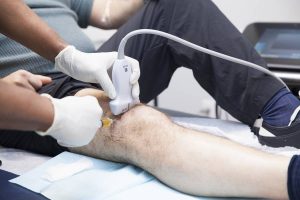Ultrasound-Guided Platelet Rich Plasma (PRP) Injections
Proudly serving Agoura Hills, Tarzana and Los Angeles County
 Biological therapies for knee osteoarthritis, such as platelet-rich plasma, are also available and may improve clinical and structural outcomes by delivering a high concentration of growth factors. This therapy may reduce pain, inflammation, and improve overall functionality.
Biological therapies for knee osteoarthritis, such as platelet-rich plasma, are also available and may improve clinical and structural outcomes by delivering a high concentration of growth factors. This therapy may reduce pain, inflammation, and improve overall functionality.
Studies have shown PRP may be utilized in the management of tendon and muscle injuries as well as osteoarthritis.
- Prior to the injection:
- No NSAID’s (Motrin, Aleve, Ibuprofen, Advil) for two weeks prior to the procedure
- Increase fluid intake 24 hours prior to the procedure
- No steroid injections within the past 2-3 weeks
- After the injection:
- Discomfort and/or pain is expected and is worse in the 20-30 minutes immediately following the procedure
- After that, most patients report soreness/some pain that persists for about one week (depending on the patient/area of injection)
- Icing may be beneficial in reducing pain
- NO NSAID’s are allowed within the first 4 weeks after the procedure
- Tylenol or other pain medications are allowed but only recommended short term (for the first week or so)
- For lower extremity injections, high impact activities (running, jumping, spinning, etc) are prohibited for the first 2-4 weeks
- For upper extremity injections, heavy lifting and excessive upper extremity activities are prohibited for the first 2-4 weeks
- At your follow-up (usually 2-4 weeks after the injection), the doctor will determine what activities can be added back in and if physical therapy should be started at that time
- Risks of the injection
- Risk of infection is present any time the skin is broken, but is a low risk
- For PRP, risks are minimal as the substance being injected is derived from your own blood
- Risk of skin blanching (turning white), skin dimpling, and fat necrosis/skin atrophy at the injection site. These risks are uncommon but can occur and may take up to one or more years to resolve. Rarely, they can be permanent.
- Prior to the injection:
- No NSAID’s (Motrin, Aleve, ibuprofen) for two weeks prior to the procedure
- Increase fluid intake 24 hours prior to the procedure
- No steroid injections within the past 2-3 weeks
- After the injection:
- Some discomfort and/or pain is expected and is worse in the 20-30 minutes immediately following the procedure
- Icing may be beneficial in reducing pain
- No NSAID’s are allowed within the first 4 weeks after the procedure
- Only if needed, Tylenol or other pain medications are allowed but only recommended short term (up to 7 days)
- High impact or strenuous activities (running, jumping, excessive walking, heavy weight lifting, etc.) are not recommended for the first 48 hours after the injection
- Risks of the injection
- Risk of infection is present any time the skin is broken but is a low risk
- For PRP, risks are minimal as the substance being injected is derived from your own blood







